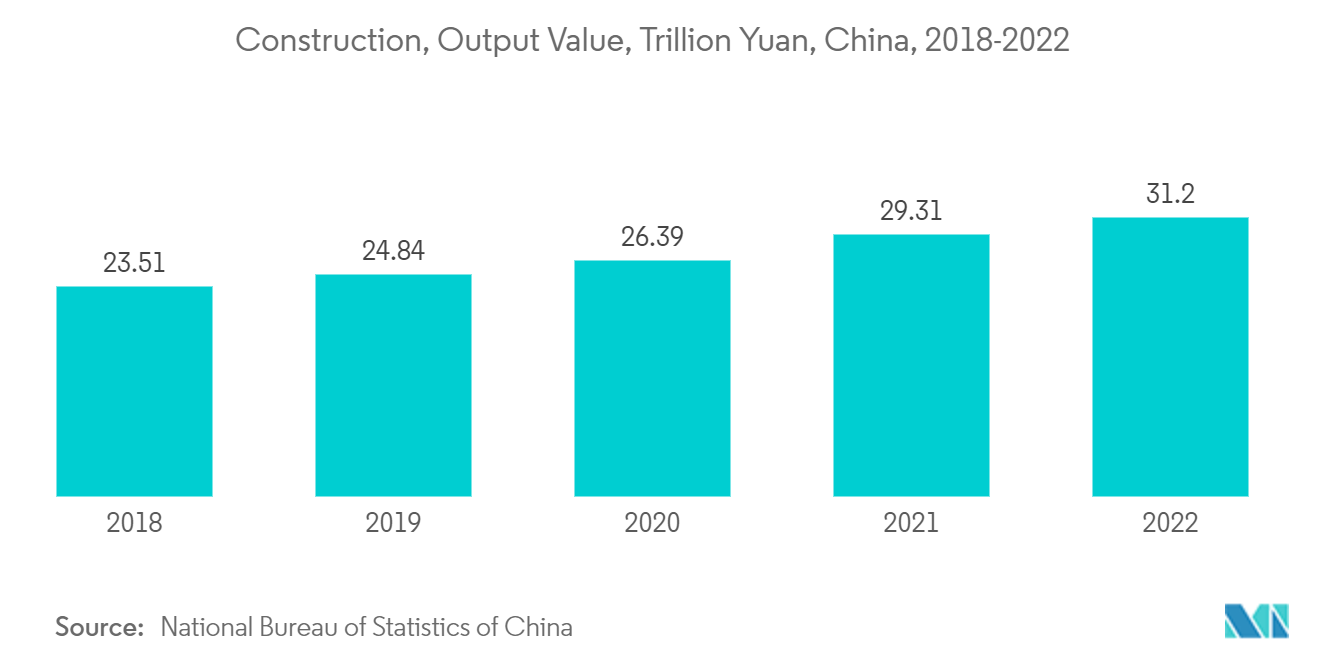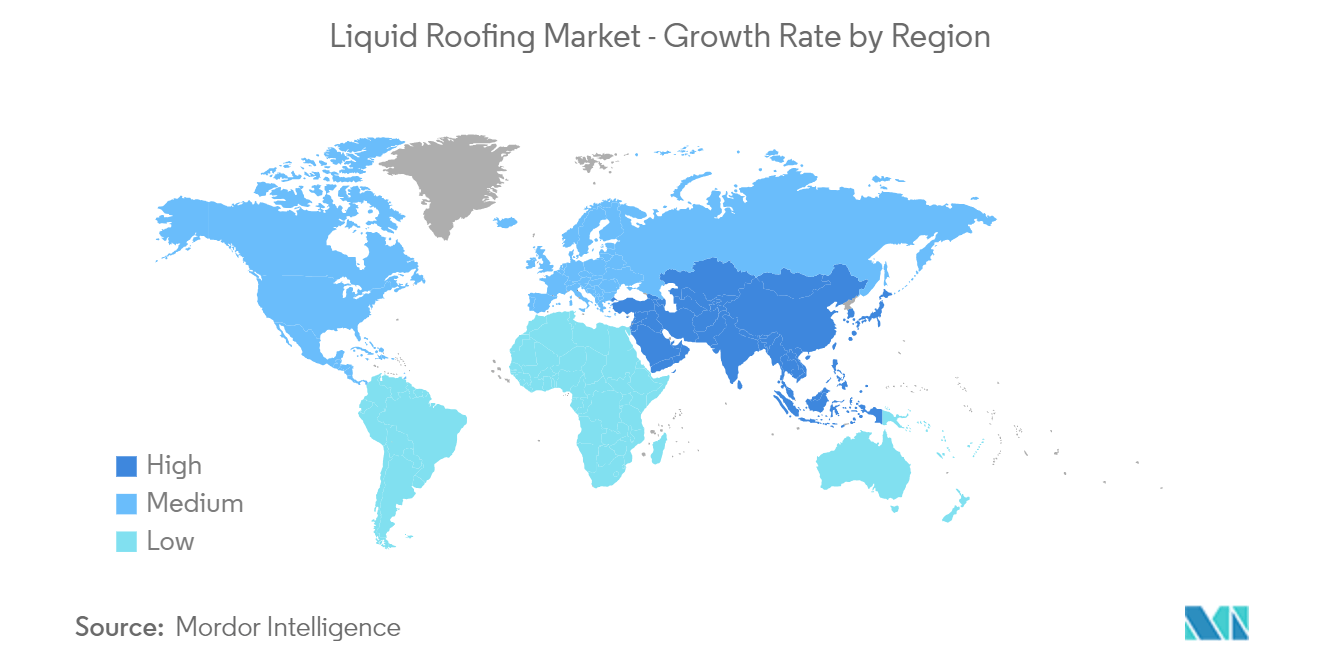Market Trends of Liquid Roofing Industry
Residential Segment to Dominate the Market
- The residential sector stands to be the dominating segment owing to the large-scale consumption of liquid roofing in the construction industry.
- Beneficial attributes like long-term roofs, lower maintenance costs, and more value as life cycle costs decrease with liquid roofing. Increasing awareness and acceptability among consumers regarding liquid roofing is expected to drive market growth.
- Among types, the silicone coating is utilized in structures and building roofs due to its advantages over other fluid membranes, such as weathering resistance, UV protection, volatile organic compound tolerance, and durability, and provides construction owners with an alternative to an expensive re-roofing project.
- Refurbishing and renovation of old buildings have increased investments in the building and construction industry and are anticipated to contribute to a rise in market demand in the upcoming years.
- Asia-Pacific countries like China, India, and South Korea have been registering strong growth in construction and remodeling activities, and the requirement for a liquid roofing market is projected to increase in this region in the forecast period.
- Factors such as rapid urban migration in major economies, increased government spending in the real estate market for residential construction, and the growing demand for high-class residential homes are likely to benefit the growth of the construction industry.
- In 2022, the construction output value in China achieved its peak at around CNY 31.2 trillion.
- In North America, the United States has a major share in the construction industry. Besides the United States, Canada and Mexico contribute significantly to the construction sector investments.
- The annual value of residential construction in the United States was valued at USD 908 billion in 2022, an increase of 13% compared to USD 803 billion in 2021.
- In Canada, various government projects, including the Affordable Housing Initiative (AHI), New Building Canada Plan (NBCP), and Made in Canada, are set to hugely support the sector’s expansion. In August 2022, the Canadian government announced a significant investment of more than USD 2 billion to fund three important initiatives that will collectively help to develop approximately 17,000 houses for families across the nation, including thousands of affordable housing units.
- In 2022, according to the American Institute of Architects (AIA) Consensus Construction Forecast, construction spending on buildings grew by an estimated 9% in 2022, and it is anticipated to grow by an additional 6% in 2023. This outlook is slightly more optimistic than forecasted at the beginning of 2022. This was largely due to strong growth in the manufacturing sector and growing strength in retail facilities.
- Europe's construction sector grew by 2.5% in 2022, owing to new investments from the European Union Recovery Fund. Business confidence picked up in early 2022 and is expected to reach pre-COVID-19 levels despite price pressures at most EU construction firms. Moreover, as the COVID-19 crisis abates and builders become less reluctant to invest in new corporate buildings and renovate existing properties, non-residential construction is expected to pick up the pace, thus supporting overall growth in the construction market.

Asia-Pacific Region to Dominate the Market
- According to Oxford Economics, the global construction industry is expected to grow by USD 4.5 trillion, or 42%, between 2020 and 2030. Additionally, China, India, the United States, and Indonesia are expected to account for 58.3% of global growth in construction between 2020 and 2030.
- Factors such as expansion in the residential and commercial construction sector will drive the market growth in the region.
- Liquid roofing systems are highly tenable, lower maintenance costs, are proven to be more durable than other waterproofing systems, are long-lasting, and aid in the prevention of uneven spots, bumps, any overlaps over the roof surface, etc.
- Rising government plans for advancing infrastructures, such as Vietnam's Socio-Economic Development Plan, Indonesia's National Medium-Term Development Plan, Philippine Development Plan, and other country's plans are expected to drive market growth.
- Emerging demand for energy-efficient structures, expanding awareness about the cost-effectiveness of liquid roofing, and increasing construction activities worldwide will further accelerate the liquid roofing market in the forecast period.
- India's construction industry was valued at over three trillion Indian rupees in the fourth quarter of 2022. This was a significant increase compared to 2020 when the value shrank due to the COVID-19 pandemic. The country’s construction and manufacturing industries were among the worst hit at the time. However, the industry seemed to recover quickly and returned to pre-crisis level again.
- China's construction industry, one of the world's largest, has experienced significant growth in recent decades. China is undergoing rapid urbanization and industrialization, increasing construction activities such as residential, commercial, and infrastructure construction. In recent years, however, the construction industry has been under constant pressure from property developers' deleveraging measures, leading to more sustainable construction practices.
- In China, the infrastructure projects in development or execution of over USD 25 million as of May 2022 were worth over USD 5 trillion. The United States and India were the following countries on the list, with around USD 2 trillion worth of infrastructure projects. In contrast, the country with the highest number of big infrastructure projects was India.
- Hence, all such market trends are expected to drive the demand for liquid roofing market in the region during the forecast period.


